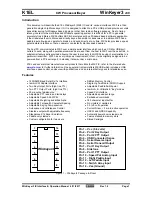
Owner Installation Instructions
DCB-05V2 Gate Controller
17
Fig 14.1
Fig 14.2
Technical Specifications
Protection rating:
IP56 (only when unit is sealed with correct cable glands)
24VDC accessory output
24VDC (unfiltered) 3Amp maximum
Secondary voltage:
24V AC
Motor voltage:
12 to 24V DC @ 10AMPS max combined
Receiver type:
TrioCode™128 Technology
Receiver code storage capacity:
30 x 4 Button Transmitter Codes
Transmitter frequency:
433.92 MHz
Coding type:
Hopping Code
No. of code combinations:
Over 100 billion random codes
Code generation:
Non-linear encryption algorithm
Transmitter battery:
CR2032
NOTE:
Specifications are subject to change without notice.
17. Specifications
Fig 15.1
When batteries reach the end of their usual life in accordance with
Australian Battery Recycling Initiative please follow the next simple
steps for protecting the environment.
Refer to the Automatic Technology website for information on where
to recycle batteries in Australia.
DO NOT
throw the batteries in
municipal waste. This symbol of the
crossed out wheeled bin indicates that
the battery should not be placed in
the municipal waste. Check your local
regulations for appropriate disposal of
the batteries.
Recycling all batteries will have other environmental and social benefits:
•
Some batteries are less toxic but hazardous for other reasons.
Lithium batteries can explode or catch fire in landfill, while button
cells are dangerous if swallowed by children. Recycling offers a safe
and environmentally responsible solution for end of life batteries.
•
Battery recycling recovers non-renewable materials such as lead,
cadmium, stella, zinc, manganese, cobalt, silver, plastics and rare
earth elements.
•
Removal of batteries and other hazardous household products from
household waste facilitates the recovery of organic materials through
alternative waste technologies such as composting. Batteries and
heavy metals are known contaminants in compost.
•
The community supports recycling because it reduces waste to
landfill and achieves environmental benefits.
WARNING!
Prior to disposal,
recycling, or collection, all battery
terminals must be securely insulated
with a non conductive material to
prevent any two batteries from short
circuiting and generating heat during
storage or transport. Battery terminals
may be insulated with electrical tape;
or batteries may be individually
packaged in a non conductive material
(e.g., plastic bag or original packaging).
16. Battery Disposal
















































